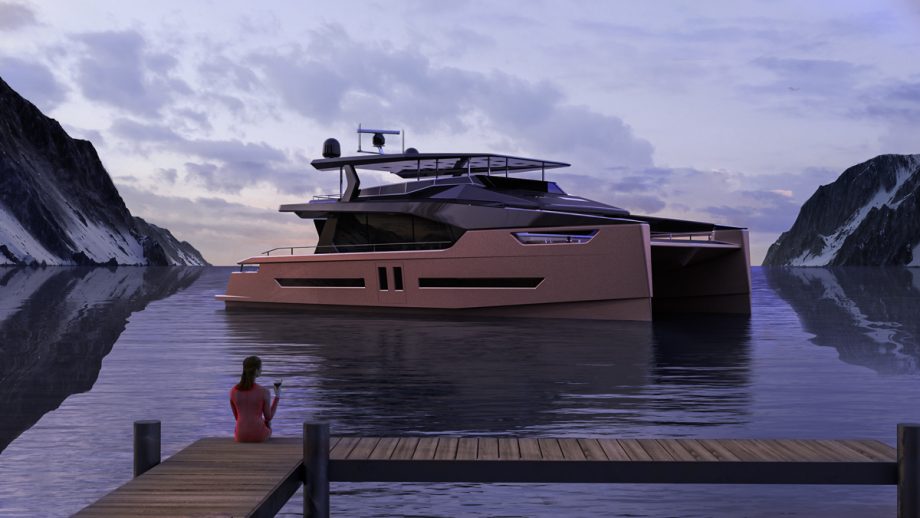A 90ft superyacht that uses no fossil fuel at all sounds too good to be true but that’s exactly what Alva Yachts Ocean has already started building…
German newcomer Alva Yachts is building what is claimed to be the first zero-emissions supercat. Unlike existing solar-powered motor catamarans that rely on diesel-powered generators to boost speed and range, the Alva Ocean Eco 90 H2 will carry no fossil fuels whatsoever.
For the few occasions when neither the extensive solar panels nor the battery pack can cope with the demand of the yacht’s electric motors and hotel loads, it will use hydrogen-powered fuel cells to generate electricity while emitting nothing but water. It also boasts a pair of automated wingsails to increase cruising speeds and range yet further.
Remarkably, this isn’t some futuristic pipedream but a real electric boat that is already in build at Alva’s production facility in Turkey, with an expected launch date of late 2024.
Safety in numbers
Central to the Alva Ocean Eco 90 H2’s ability to cope without an internal combustion engine is the fact that it doesn’t rely on any one source of power.
When the sun is shining, the 200m2 of photovoltaic panels integrated into the flybridge hardtop and coachroof generate enough electrical energy (up to 40kWp) to power the yacht’s two electric motors at 3-4 knots and run all the ship’s systems (air con included).
For faster cruising speeds or cloudier conditions, a vast 500kWh reserve of lithium ion batteries (10 x the power of a standard Tesla 3 car battery) should still give a cruising range of at least 50nm at 5-7 knots.
Article continues below…

Energy Observer: This space-age catamaran/floating lab is powered by water

ZEN 50 first look: This electric wingsail powercat is completely fossil-fuel free
Flat out, the twin 480kW electric motors are capable of up to 12 knots, but this does come at the cost of a considerably reduced range. Only when demand exceeds the combined output of both the solar panels and the battery pack will the hydrogen fuel cells kick in.
These are being supplied by EODev, which has real-world experience of using hydrogen fuel cells to propel boats thanks to Energy Observer, the experimental catamaran that has already cruised around the world using a combination of solar and hydrogen power.
The Alva Ocean Eco 90 H2 will use EODev’s latest REX H2 fuel cells, which have been developed jointly with Toyota for use in marine applications. These work by passing hydrogen through a fuel cell that uses a platinum catalyst anode to split the hydrogen into positively charged ions and negatively charged electrons.

A computer decides which power source to use
A polymer electrolyte membrane allows the positive ions to flow directly through to the cathode while the negatively charged electrons have to travel round an external circuit to the anode where they recombine with oxygen to create water (H2O), electricity and a small amount of heat. Each of these fuel cells develops up to 70kW and can be stacked to deliver more power.
Alva hasn’t yet confirmed how many of these fuel cells or how much hydrogen the yacht will carry, or what cruising range this will allow, but we do know the hydrogen will be stored in high-pressure tanks to minimise the amount of space required. Refuelling is likely to take place from specially adapted road tankers at a pre-arranged dockside location.
Wings not sails
The addition of wingsails to the Alva Ocean Eco 90 H2 are not considered a strict necessity but will deliver faster cruising speeds and/or reduced power consumption even in light winds. Unlike conventional sails, these are semi-rigid double-skinned wing-shaped structures that require no additional rigging and no previous sailing knowledge to operate.

Going Eco doesn’t mean skimping on luxuries
Consisting of two independently rotating sections to adjust the angle of attack and camber of the wing, they work by creating high pressure on one side and low pressure on the other as the wind flows past them, helping drive the yacht forwards regardless of where the wind is coming from.
The beauty of wingsails, in this case a pair of Ayro Oceanwings, is that the whole system can be automated. Sensors on the wings measure the wind speed and direction, a computer analyses the data then instructs the motors to adjust the wings accordingly.
This makes them more efficient than conventional sails (Ayro claims double the performance) but also far less hassle. They can also be raised, lowered and reefed at the touch of a button when the winds are too weak or strong to deploy them.

Guests can relax in the palatial main deck saloon
Computer says yes
Controlling all these systems is Alva Connect, the yard’s in-house software that continuously monitors the ship’s power requirements and seamlessly juggles the four different power sources (solar, battery, fuel cell and wing sails). The captain selects the speed and heading and the computer works out the rest, leaving guests to revel in the carbon-free, near-silent progress.
The first Alva Ocean Eco 90 H2 is being fitted out for both private and commercial use as a fully coded charter yacht. Based in the Med, it will feature a lavish owners’ suite with a study, walk-in wardrobe and bathroom, and three further double guest cabins, all with their own ensuites.
The exact price of the build remains confidential but a standard Alva Ocean 90 with a solar electric drivetrain and diesel range-extenders starts at around €7 million ex taxes.
Alva Ocean Eco 90 specifications
LOA: 90ft 1in (27.50m)
Beam: 35ft 9in (13.98m)
Draft: 3ft 10in (1.2m)
Displacement: 85 tonnes (light)
Motors: 2 x 480kW electric
Battery: 500kWh lithium ion
Solar panels: 40kWp
Fuel cell: 70kW hydrogen
Wingsails: Ayro Oceanwings
Max speed: 12 knots
Range: Unlimited @ 3-4 knots






























